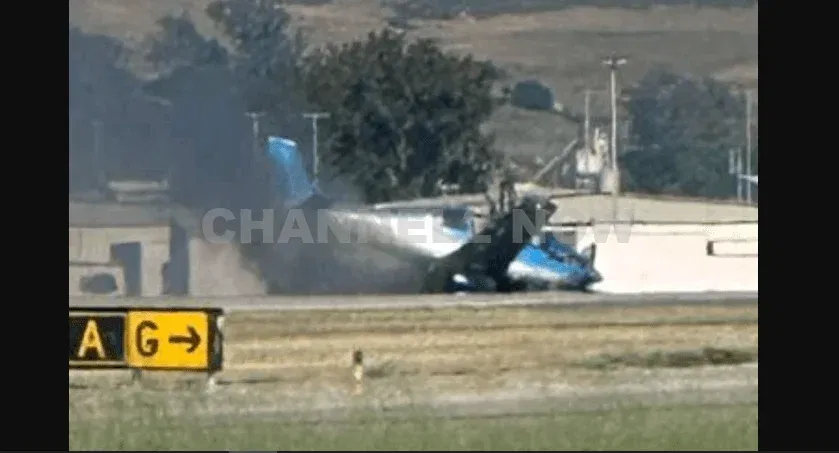On a day that began like any other at San Luis Obispo County Regional Airport, located in the serene Central Coast of California, a routine flight took a harrowing turn, culminating in a fiery crash that sent emergency crews scrambling and momentarily disrupted operations at the well-trafficked regional hub. The incident, which occurred in the vicinity of 975 Airport Drive, involved a single-engine aircraft that not only crashed but ignited upon impact, producing scenes of urgent chaos and prompting swift action from first responders.
The crash unfolded in stark contrast to the airport’s otherwise quiet and meticulously organized atmosphere. While the names of the occupants have not yet been publicly released, officials confirmed that two individuals were aboard the aircraft at the time of the crash. Remarkably, both were able to escape the wreckage before it was fully engulfed in flames. Their survival, despite the circumstances, is a testament to both their luck and the immediate response efforts.
Eyewitnesses, who reported hearing a low-pitched sputtering noise followed by a loud thud and then the unmistakable roar of fire, watched in disbelief as emergency services raced to the scene. Airport fire crews, already stationed within close proximity to the tarmac, arrived in minutes, deploying foam and extinguishing agents to quell the flames. The swift extinguishment of the fire likely prevented further injury or infrastructural damage. Simultaneously, emergency medical personnel conducted rapid assessments of the two individuals, who were reportedly alert upon evaluation. However, the specific nature and extent of their injuries have not been officially disclosed, leaving a crucial gap in the public’s understanding of the potential long-term implications.
The exact cause of the crash remains shrouded in uncertainty. As per protocol, officials from both the Federal Aviation Administration (FAA) and the National Transportation Safety Board (NTSB) were immediately notified and are expected to undertake a comprehensive investigation. Their roles, while overlapping in purpose, are distinct in practice. The FAA will focus primarily on the regulatory and airworthiness aspects of the aircraft—scrutinizing maintenance logs, pilot certification, and operational adherence—while the NTSB will delve into the mechanics and sequences that led to the crash, including possible equipment failure, environmental conditions, and human factors.
The crash underscores the inherent risks associated with general aviation, particularly with single-engine aircraft, which while widely used for personal, instructional, and smaller commercial flights, carry higher statistical vulnerability in certain flight regimes. San Luis Obispo County Regional Airport, known officially as SBP, handles a mixture of commercial and general aviation traffic, and its proximity to both urban infrastructure and natural terrain can present unique navigational and environmental challenges, especially in low-visibility or emergency situations.
Historically, general aviation accounts for the majority of aviation incidents reported annually by the NTSB. According to past reports, approximately 1,200 accidents involving fixed-wing single-engine aircraft occur in the United States each year. While the overwhelming majority are non-fatal, they often result in significant aircraft damage and, in more severe cases, serious injury or loss of life. The survival of both individuals in this incident thus places this crash in the less frequent category of high-damage, low-fatality events.
Airport operations were temporarily halted as a safety precaution, allowing for both emergency response and preliminary hazard assessments. Flights were delayed or rerouted, and a temporary ground hold was issued for arriving aircraft. Crews also conducted an environmental assessment of the crash site, checking for fuel spills and fire-related damage to nearby structures, runway surfaces, and navigational equipment. Officials emphasized that despite the severity of the fire, no secondary damage to airport infrastructure had been reported.
Public safety and transparency are paramount during incidents of this nature, and officials have assured that further updates will be disseminated as the investigation progresses. Inquiries into the identity of the aircraft, the nature of its flight plan, and the qualifications of its occupants will form essential pillars of the FAA and NTSB probes.
In the broader context, such incidents prompt renewed discussions about aviation safety standards, particularly for private aircraft operators and smaller regional airports. Issues such as pilot recertification frequency, aircraft maintenance regulation, and runway safety enhancements often come under renewed scrutiny in the aftermath of crashes.
Community response has been marked by concern and relief. Local residents, many of whom live within view of the airport’s perimeter, expressed anxiety about the potential for more severe outcomes. “We heard it go down and just ran to the fence,” one resident said. “Seeing the smoke and knowing someone was inside was terrifying. I’m just glad they got out.”
Airport officials and local authorities are coordinating with federal agencies not only for the investigation but also to debrief staff and provide mental health resources for any personnel impacted by the traumatic nature of the crash response.
As the story continues to unfold, the San Luis Obispo County Regional Airport community, aviation enthusiasts, and safety advocates await a clearer picture of what led to this frightening event. For now, the fortunate survival of the aircraft’s two occupants serves as a sobering yet hopeful reminder of the importance of preparedness, the effectiveness of emergency protocols, and the resilience of those who navigate the skies.


Leave a Reply